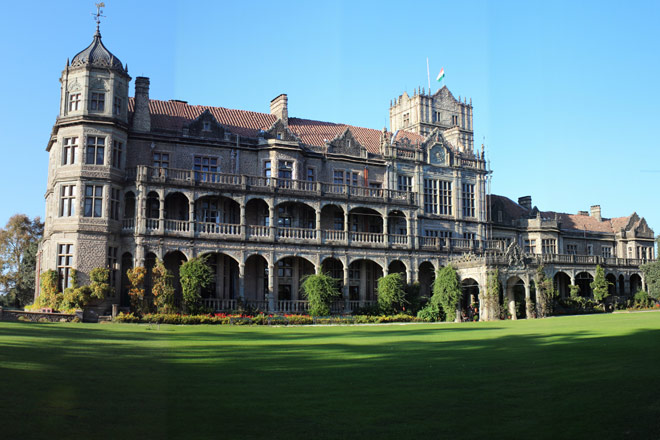From architecture to drama, there are enormous well kept secrets in the arms of the hills. Experiencing the undiscovered in Shimla, Himachal Pradesh.
As we took the sharp turns towards our destination, the glimpse of the starry city was serene and clear. With the tall deodar and oaks bordering the roads, Shimla or Simla, as it was formerly known, was facing us bold and bright, 8 kms the milestone read. This was not my first visit to the summer capital of the British Raj but the incipient visit for a purpose. A purpose of looking what goes unnoticed amongst the chilly winds and picturesque green mountains. If you were visiting the city, 50 years ago, the story would have been different. What was safely hidden under the folds of a pristine culture is now a hub of activity and zeal for tourists. 50 yrs ago, perhaps you would find peace residing in each corner in the queen of hills, perhaps a walk to the Mall Road would rejuvenate you mentally, perhaps the city which bellows old world charisma would sense like one too. It’s hard to believe that one of the earliest Colonial establishments in India isn’t remembered as a historic milestone but as a summer pursuit.
Spread on a ridge and seven spurs, Shimla was laid out in levels. In a panoramic view of the city, you could view the sloping British roofs in unending rows of clustered houses; the neo-gothic architecture is hard to miss the eye of an observer. Take a stroll on the extensions along the roads made for pedestrians and you’ll notice the fancy buildings, the elegant white entrances to pathways which lead to the vintage charms and people more than willing to help out for the way.
Amidst everything you reach for when you visitation visited visiting the place, there is more than what meets the eye. Rarely does one reflect upon the illustrious historical past that the high rising oaks and monuments standing as the testaments of the Raj depict.
Nostalgia hits you deep when you enter the forbidden silence prevalent on the Observatory hill. The vehicle stops with a thud and in front of you is the entrance to the cast lawns and stillness of what once used to be the residence for the once viceroy of India, Lord Lytton. Rashtrapati Niwas, formerly known as Viceregal Lodge is one of the purest examples of Tudor style architecture and clearly the quietest of places in Shimla. Its like the tranquility of zen at an administrative place, a phenomenon impossible in a metro. But surprisingly, the place has gone in the books of history for creating hustle bustle on the streets of Shimla. The viceroy held meetings with the congress leaders in the mornings and ballet in the evening. It is said that the Shimla agreement regarding Pakistan was signed at this very spot. But far away from all the above facts is twist to the story. Legend has it that beneath the Lodge was a torture house built by the British. This sounds quite believable because the place carries with it an emptiness unfulfilled by the beauty of the surroundings. True or not, people of Shimla want to believe it. For them, its another reason to hate the British. Presently, the place holds a museum and library within the premises and occasionally houses foreign delegates for visits.
While the structure stands tall and holds secrets unspoken, memories of the Raj don’t end here. Reminiscent of the pre-independence era, Town Hall stands erect surrounded by the Mall Road on both sides. The municipal corporation office still resides in the building. Although now renovated, it is the face of the busiest part of the city and retains its original architecture. What brings back the old and grandeur memories of the era and is a part of the town hall complex, The Gaiety Theatre. Built by Henry Irwin, this is one marvel untouched by the urbanization in the city. The theatre can hold 300 people with special seats for viceroys and other eminent personalities and still works on the screen made by Irwin. Even the slightest of sounds on the stage are audible to the audience sitting on the very last seat. “Yahan mic ki zarurat nahi!” exclaims Sunil, one of the workers at the theatre while we moved our way up towards the seats. With a rich history, the theatre held commendable literary works of writers like Rudyard Kipling in its heart and the traditions are still alive. If you walk in to the theatre, you can easily catch up on a theatre performance by one of the many dramatic societies in Shimla. Interestingly, The Gaiety is the only Gothic theatre in Asia amongst a total of six in the world. What fascinates me is the sheer enthusiasm by which tourists ignore sites like these for a little more luxurious scenario, seldom do people notice the realities of why a place gained so much historic importance and why visiting it makes sense.
As we start paying attention to the other obvious parts of this cultural land, the scents of the last visited sites remain with us for as long as the feeling does. There is a sense of losing all of this into oblivion, but a belief that the heritage isn’t falling apart, the locals believe the same.
This time Shimla was delving into the undiscovered realms of the past which enraptured our senses, made us yearn for the time gone by and appreciate what the city is struggling to keep alive. The legacy of a thousand dreams, the voices of the 80’s. And after knowing the kind inheritance Shimla keeps bundled up in itself, it won’t let go of what makes it different, what brings past to life.



October 15, 2014